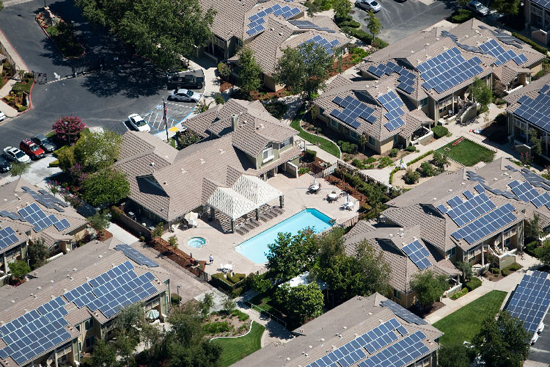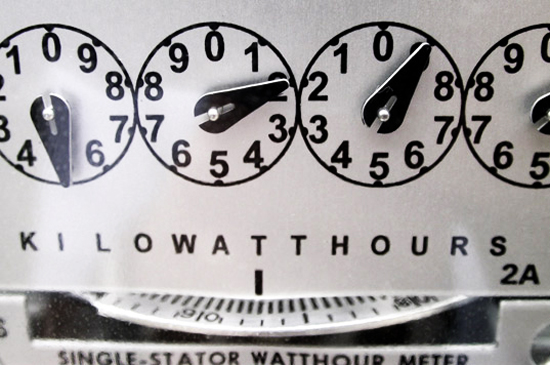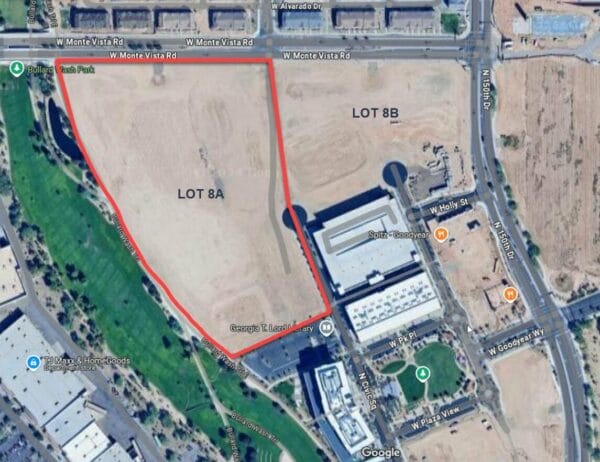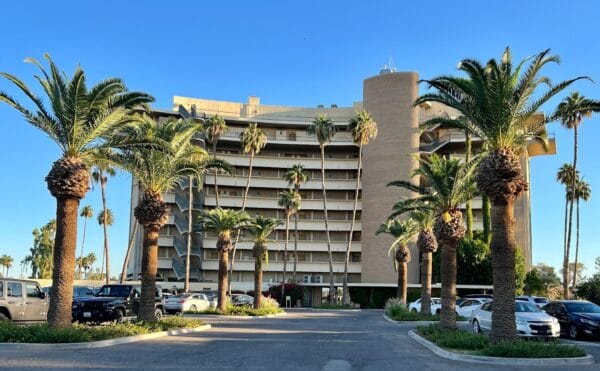A program that pays California residents for electricity made by their rooftop solar panels is under scrutiny, and supporters fear it could be weakened.
The California Public Utilities Commission (CPUC) is examining the costs and benefits of net energy metering, a system that allows households and businesses with green power to earn credit for surplus electricity fed into the grid.
Advocates say it’s driven expansion of rooftop solar and locally based energy, also known as distributed generation.
“It is the anchor policy for distributed generation in California,” said Adam Browning, executive director of Vote Solar, a San Francisco-based group. “Without it, the distributed generation solar market comes to a close. It’s as simple as that.”
Utilities, however, argue that net metering creates a hierarchy among consumers. It forces those without solar to subsidize their wealthier neighbors with panels, said Denny Boyles, renewable energy spokesman at Pacific Gas & Electric Co. (PG&E).
Solar owners use and receive the benefit of power lines and transmission facilities, he said, but pay less for those services because of net metering bill credits. Net metering beneficiaries also pay a smaller portion of support for statewide programs that help lower-income residents, Boyles said.
“Without some kind of study of the impact [of net metering], other customers are going to have to shoulder an ever-increasing percentage of that burden,” Boyles said.
Solar right now is about 1 percent of the state’s energy mix and is projected to grow to as much as 4 percent over the next decade.
“It’s relatively modest,” said Gary Stern, director of regulatory policy at utility Southern California Edison Co. (SCE), but with “the growth in this industry, it could become of some significance. It could become a few hundred million dollars of subsidy.”
Protecting consumers or profits?
Solar backers say that utility argument is a facade. Power companies don’t care about consumer bills, they said. What they’re really concerned about is that as solar grows, it reduces the need for infrastructure, which is where utilities make their profits.
“Utilities pretending to be ratepayer advocates is like Cookie Monster pretending to be a slow food advocate,” said Bryan Miller, vice president of public policy and power markets at SunRun, a San Francisco-based company.
David Crane, CEO of NRG Energy Inc., speaking March 21 at The Wall Street Journal’s ECO:nomics conference in Santa Barbara, Calif., said residential and small-business-based solar is a “mortal threat” to utilities’ business model, as utilities split their costs among increasingly fewer customers, the Journalreported. NRG has solar projects.
Stern with SCE said it’s true that “there may be less needs for transmission lines as result of local generation.” But he added that there is now competition in transmission projects, and it’s “no longer just a utility thing.”
Utilities are not viewing distributed generation “as a threat to our transmission model,” Stern said.
Until the CPUC produces its study — which is due by June — it won’t be clear which way the agency is leaning. Solar companies and utilities in the meantime are each working to frame the issue and sway regulators and lawmakers. As solar use spreads across the nation, the outcome of this battle is likely to be very influential.
Renewable power growth is controversial in other states. In Arizona, utility APS recently sent a flier to residents informing them that they would be paying more to make up the difference for expanded green energy.
“Because more customers are installing renewable energy systems such as solar and wind, and energy efficiency measures such as compact fluorescent light bulbs and refrigerator recycling, APS is selling less electricity, but fixed costs remain. APS is allowed to implement a new charge to recover a portion of the fixed costs,” the flier said. “A new charge will begin appearing on affected customers’ bills in March 2013 in one of two forms: a flat addition to the existing customer charge (Flat Charge Option) or a new Lost Fixed Cost Recovery (LFCR) percentage of bill charge.”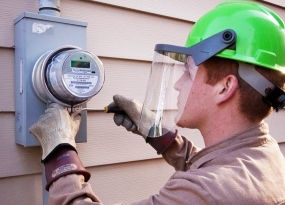
Browning said: “There are attacks on access to net energy metering out there. That’s why we’re continuing to educate policymakers and stakeholders on the value of net metering and of distributed generation, to make sure that everybody understands what’s at stake so we can continue to enjoy the benefits.”
In California, the contest has been building since last May, when the CPUC revised the formula utilities use to limit the number of customers eligible for net metering. That ceiling would be hit when the amount of power generated by houses and businesses with solar hits 5 percent of “aggregated customer peak demand.” The CPUC changed the definition of “peak demand” in a way that’s expected to allow potentially twice as much rooftop solar to qualify for net metering (ClimateWire, May 25, 2012). Utilities have been contesting that ruling.
“The cap hasn’t been interpreted properly,” Stern said. “That could lead to eventually subsidies that are too large, too many customers who are taking advantage of the system at the expense of other customers.”
Legislation directs state study
Utilities have won help from a key lawmaker. Assemblyman Steven Bradford (D), chairman of the Committee on Utilities and Commerce, offered A.B. 2514, which passed last year. It required regulators to analyze whether customers under net metering are “paying the full cost of the services provided to them by the investor-owned utilities.” It also required regulators to look at “the extent to which customers receiving net metering pay their share of the costs of public purpose programs.”
Bradford previously worked for SCE. Solar companies say that gives utilities an inside track. However, the assemblyman said he supports solar energy but believes more data are essential.
“We need to get an understanding of the costs and benefits of net metering,” Bradford said. “Utilities say it is expensive, while the solar industry says it benefits the ratepayers. A.B. 2514 simply requires the PUC to do the accounting and let us know the results so the Legislature and the public get a better understanding of how to design and implement sustainable programs to promote clean generation.”
Solar businesses funded their own study, which they said shows that distributed solar and net metering benefit all ratepayers.
The excess energy is 100 percent clean and goes to the nearest neighbors of those with solar power, said Tom Beach, principal at Crossborder Energy, the Berkeley, Calif.-based consulting firm that produced the study.
“It uses almost none of the utility’s transmission and distribution system,” Beach said of the surplus solar power. The utility doesn’t have to generate energy from a distant power plant, he said, or add transmission lines all over the state. Those savings in the distribution system benefit other utility customers, he said.
However, Boyles with PG&E said utilities actually have to have natural gas power plants to meet demand when solar isn’t generating energy and have needed to add infrastructure to back up solar.
Higher fixed charges?
Along with the net metering study, the CPUC also is looking at power rates. Some of the utilities are arguing that there needs to be a change in the structure. Right now California uses a tiered structure, in which rates sharply increase as consumption rises. It’s intended to promote conservation.
Stern with SCE argues that existing tiered rates are a problem when combined with growth in rooftop solar. People who add solar, he said, tend to be among the largest users of energy. But because of credits from net metering, those customers aren’t paying in the top tier. The utility still has to provide that energy during times when the sun isn’t shining, he said.
One option for the CPUC to consider is a flat charge all customers would pay, he said. SCE has one now that’s about 80 cents per month, “lower than anywhere in the country,” he said. There needs to be something more like $5 per month, he said.
“We’d like to move in that direction,” Stern said. “Exactly how far is a debate we need to have movement toward.”
Solar backers said a higher fixed charge would hurt renewable power. There is less incentive for people to add green systems or energy efficiency measures, said Browning with Vote Solar, because they are “not moving the needle as much. Reducing energy usage, you don’t get as much value out of it.”

